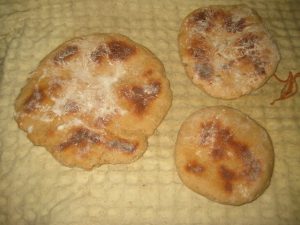Since I don’t have any urges to work on NihAV at this moment (big surprise, I know) I’ll talk about cooking instead.
Since I don’t know how to cook and never had any kind of culinary education, I divide dough into three main categories: puffy (the one that expands while baking), non-puffy (the one that keeps about the same volume) and runny (usually used for pancakes but we’ll talk about them later).
Non-puffy dough is the easiest to make: just mix flour and water (take either boiling water or very cold water for good results). Ideal for simple filling dishes like вареники or Karelian rice pasty (I made both and shall probably make again). The next level is to make so-called shortcrust pastry which is used for pies, quiches and such. Here you usually mix flour with some fat and/or filling (called shortening).
And there we have a variety of what to use for shortening:
- classical recipes use butter—I’ve cooked stuff using it and it works fine except that it takes too much butter to my liking;
- French people obviously prefer margarine (since it’s their invention)—I see no reason to try it;
- Brits prefer some weird animal fat called suet—I feel queasy just thinking about it so it gets definitive no from me;
- USians use chemically processed vegetable shortening; I’ve tried it once: ordered a can of Crisco shortening, followed the recipe for pie crust and the result is bad. I’d stick to other two recipes listed here. Fun fact: while searching for it on Amazon most offers were from sex shops where it’s apparently offered as a lubricant. I can see why—that stuff is sticky and slick and not fit for baking. Also since one of the sellers offers it along with various sweets (and what passes for them in the USA) I’ve ordered some of those and tried it—I was not impressed by that stuff either.
- and finally there’s German variant that I find very good called Öl-Quark Teig (dough made from oil and quark—in this case lean homogenous cottage cheese). You mix flour with several spoonfuls of oil (you can choose different oil for different flavouring of course, which is a nice feature) and magerquark (lean homogenous cottage cheese) and that’s all! You can add an egg and/or baking powder too but it’s fine as is too.
Puffy dough is the trickiest one—the puffiness comes from bubbles in the dough and it takes extra effort to do that. The easiest way is simply to add baking powder (or baking soda reacting with vinegar) to the dough, the other conventional ways are to prepare yeast (cultured or uncultured, either way it takes time and some effort) or make bubbles from eggs which requires some skill that I lack (so I stick to baking powder). There are two recipes that work for me: mixing flour, eggs, butter and sugar (aka the usual cake mix) or öl-quark dough with sugar, egg and baking powder.
Runny dough (is it called batter?) can be made by mixing flour with a lot of liquid and some eggs and then used to make pancakes. Since it’s the only thing I’ve done with it so far let’s talk about them.
There are several kinds of pancakes that I know and tried so far:
- French-style thin pancakes (aka crêpes) that are better eaten fresh with something rolled in;
- Dutch laughably small pancakes (that have a name almost like an Australian word for gay—probably the words have the same origin);
- common pancakes—thicker than crêpe, plain, good to eat with something on top or with some filling rolled in;
- slightly thicker pancakes with something embedded in them (like bits of ham).
And of course Sweden has nice varieties of pancakes in wide range: ordinary pancakes, pancakes with bits of ham, pancakes with potatoes (I tried those and approve) and pancakes for people like me who can’t do anything right with their hands (including flipping pancakes)—ugnspannkaka, i.e. pancakes baked in oven. Obviously that one is much thicker than the rest but it’s easy to make (even I baked some) and it can embed various stuff too which makes it interesting (bits of ham, fish or even fruit). Also this way you’re more likely to end with rectangular pancakes which I find to be a nicer and more versatile shape than usual round ones.
I forgot to mention one local thing—in Baden-Württemberg they have plain pancakes shredded into thin stripes, dried and then they add it to the served soups. It’s called Flädle and you can buy it in every local supermarket (even Aldi). It’s a nice addition to a soup IMO.
Okay, now back to doing anything but coding.
